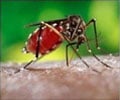UN chief Ban Ki-moon on Friday kicked off an ambitious global initiative to eliminate malaria in Africa by the end of 2010, including the delivery of 250-million insecticide-treated beds.
UN chief Ban Ki-moon on Friday kicked off an ambitious global initiative to eliminate malaria in Africa by the end of 2010, including the delivery of 250-million insecticide-treated beds.
In a video announcement from the UN office in Vienna to mark the first World Malaria Day, the UN secretary general said he was putting forward "a bold but achievable vision" aimed at ending malaria deaths by the end of 2010."We have the resources and the know-how. But we have less than 1,000 days," he added.
The multi-billion dollar (euro) initiative will start with the delivery of 250 million insecticide-treated bed nets by the end of 2010 to those parts of the African continent where the deadly disease is endemic.
"It is unacceptable that malaria still kills more than one million people, most children, every year,' said Ann Veneman, executive director of the United Nations Children's Fund (UNICEF).
Ninety percent of victims live in sub-Saharan Africa, and the vast majority of those are infants and children.
Each day, some 3,000 young lives -- one every 30 seconds -- are snuffed out by the mosquito-borne parasite that carries the disease, which provokes debilitating fever, headache and vomiting.
Advertisement
Malaria severely sickens half-a-billion people in the world each year, and kills more than a million. It exacts a terrible economic cost as well, sapping more than a full percentage point from the annual economic growth of the most affected nations.
Advertisement
It cautions, however, that climate change could pose a serious challenge to eradication efforts. Rising global temperatures threaten to spread the disease to parts of the continent -- and the world -- that are currently malaria-free.
"Near-zero mortality can only be achieved with a comprehensive approach that includes targeted spraying of insecticides, provision of effective medicines, and expanded delivery through community health workers," argue Rajat Gupta, of the Global Fund to Fight AIDS, Tuberculosis and Malaria, and Raymond Chambers of the United Nations.
They also point to two concrete examples of how dramatic progress towards these goals can be made, even in resource-starved nations.
Rwanda succeeded in reducing malaria cases by 64 percent and deaths by 66 percent in children under five in less than three years, from 2005 to 2007. Ethiopia achieved a comparable result over the same period, halving the number of cases and decreasing the death toll by 60 percent.
Both countries adopted a two-pronged strategy, focused on prevention and treatment, through the use of insecticide-treated bed nets and artemisinin-based therapies.
Artemisinin is a drug derived from a traditional Chinese medicinal plant -- Artemisia annua, or sweet wormwood -- that has proved extremely effective as a treatment for malaria.
Since 2000, artemisinin-based combination therapies (ACTs) have become the first-line treatment in the many African countries where drug-resistant strains of the disease have dramatically reduced the effectiveness of chloroquine and sulfadoxine.
Global Malaria Programme Ethiopia was spurred to action by the worst malaria epidemic on record in 2003, when the number of cases doubled to 12 million, with an estimated 100,000 child deaths.
The government aggressively sought international funding for a project to distribute 20 million bed nets in three years, receiving help from the World Bank and the Global Fund.
World Malaria Day, under the theme "Malaria -- a disease without borders," was officially launched by Roll Back Malaria (RBM), the world's leading public-private partnership against malaria, in Livingstone, Zambia in the presence of 17 southern African health ministers.
Source-AFP
SRM/K









